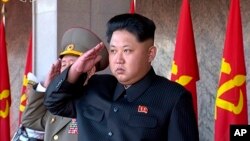North Korean leader Kim Jong Un warned that Pyongyang is "ready to fight any kind of war waged by the U.S.," as he presided over a major military parade Saturday to celebrate the 70th anniversary of the ruling Worker's Party.
State television showed tight formations of goose-stepping soldiers marching through Pyongyang's Kim Il Sung Square, as the North Korean leader looked on from a podium, surrounded by the country's other top leaders.
Very few foreign dignitaries are attending the event. But Chinese official Liu Yunshan was given a position of prominence, appearing next to Kim throughout the parade. Liu, who is China's fifth-ranked leader, is in Pyongyang for wide-ranging talks.
The start of the parade was delayed several hours because of a heavy thunderstorm that had moved through the area. But the skies later turned sunny.
At midnight Friday, Kim marked the anniversary by paying respects to his late father and grandfather, whose embalmed bodies are on display at the Kumsasan Palace in the capital.
Images released by the Korean Central News Agency showed Kim visiting the mausoleum alongside several other top officials, and bowing to the bodies of Kim Jong Il and Kim Il Sung.
Show of strength
Saturday's parade was planned as an impressive display of military might, and is one of the country's largest military parades ever, with large numbers of tanks, missile launchers and marching soldiers.
The U.S.-Korea Institute’s website, 38 North, says satellite photos taken Tuesday show about 800 tents, more than 600 trucks and 200 armored vehicles at a former air base east of Pyongyang preparing for the parade.
Last year at this time, North Korean leader Kim Jong Un had not been seen in public for over a month and missed the anniversary celebration, supposedly because he was recovering from a leg injury. His absence set off speculation about his possible ailing health and weakening grip on power.
This year, his attendance at the massive military spectacle is surely intended to bolster the power of the young Kim, who became supreme leader of the authoritarian state in 2011 after the death of his father, Kim Jong Il.
No signs of imminent rocket launch
It is looking less likely that North Korea will launch a long-range rocket or satellite test that officials recently indicated was being planned. Analysts and South Korean officials say there have been no visible signs of launch preparations.
Pyongyang’s threats of a missile launch and nuclear test were read by many as provocative acts to reinforce Kim’s hold on power and demonstrate North Korea's defiance of the U.S. and international community’s sanctions for its ballistic and nuclear program.
North Korea analyst Ahn Chan-il, with the World Institute for North Korea Studies, thinks part of the reason the missile launch has either been delayed or halted is that Pyongyang is merely behind schedule.
“There is a possibility that North Korea is not technically ready to launch a missile. They need to build up its launch pad and also add another 4,000 to 5,000 kilometers of firing range, but North Korea couldn’t solve the technical matters including fuel and timer,” he said.
Relations with China
The possible North Korean long-range missile launch sparked talk of further increasing sanctions on the Kim Jong Un government. Not only did Washington and Seoul publicly caution Pyongyang of possible punitive retaliatory measures, but so did its traditional ally Beijing.
Without China’s continued assistance in food and fuel and in trade, North Korea’s economic situation would be dire and Kim' government would be in real jeopardy.
Analyst Kang Chul-hwan, with the Center for North Korea Strategy says if a missile test does not happen, it is because the threat of increased sanctions worked.
“I think Kim Jong Un considered the crisis that could come from additional sanctions on North Korea due to a missile launch, and also China might have come up with a stronger level of pressure which North Korea could not accept,” Kang said.
Relations between China and North Korea have been tense since Kim Jong Un came to power. The North Korean leader has yet to visit Beijing and did not attend China’s military parade last month for the 70th anniversary of the end of World War II.
Beijing sent Liu Yunshan, one of the top leaders of the Communist Party of China, at the head of a high-level Chinese Communist delegation to the Pyongyang celebrations, which could be a sign of improving ties.
Pyongyang also made other recent gestures to indicate it is trying to reduce regional tensions including releasing a South Korean student who had been detained for months after he illegally crossed into the North, and agreeing to allow reunions for families separated by the division of the Korean peninsula.










